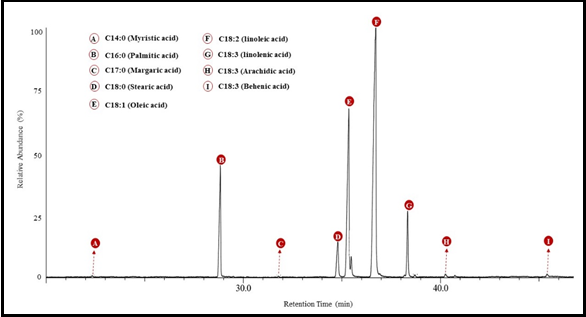Main Article Content
Abstract
The desulphurization process of diesel fuel is carried out to reduce the amount of SO2 emissions that can cause acid rain. However, the desulphurization process in diesel fuel not only removes the sulfur compounds but polyaromatic and polar compounds are also eliminated during this process. The loss of these two compounds can reduce the lubricity properties of diesel fuel. Therefore, it is necessary to add an additive compound that can increase the lubricity properties. In this research, 2-hydroxyethyl ester (HEE) was synthesized as an additive to increase the lubricity of diesel fuel. This compound was synthesized through the transesterification reaction of soybean oil and ethylene glycol with K2CO3 as the base catalyst. The composition of the synthesized additives was analyzed using the Gas Chromatography-Mass Spectrometry (GC-MS). Based on the results of GC-MS spectrum analysis, it is known that the 2-hydroxyethyl ester compound has been formed with a yield of 66.5% (relative to the area of the chromatogram peak). The HEE compound obtained is a mixture of 2 hydroxyethyl palmitate, 2 hydroxyethyl linoleate, 2 hydroxyethyl stearate, 2 hydroxyethyl arachidonate, 2 hydroxyethyl nervate, and 2 hydroxyethyl behenate.
Keywords
Article Details

This work is licensed under a Creative Commons Attribution-NonCommercial 4.0 International License.
References
- R. Y. P. Burhan, Y. Zetra, Pusparatu, Suprapto, and A. T. Hidayat, “Utilization of fatty acids from the edible oil industry in synthesis of 2-hydroxy propyl palmitate as a bioaditive solar fuel,” J. Phys.: Conf. Ser., vol. 1517, p. 012087, Apr. 2020.
- “Keputusan Direktur Jendral Minyak dan Gas Bumi. Nomor 28.K/10/DJM.T/2016.” .
- A. N. Miftachul and B. Waluyo, “Model Sistem Monitoring Minyak Pelumas Digital dengan Memanfaatkan Gaya Apung dengan Sensor Load Cell,” AutoExp, vol. 1, no. 01, pp. 24–29, Apr. 2018.
- Z. Hu, L. Zhang, and Y. Li, “Investigation of tall oil fatty acid as antiwear agent to improve the lubricity of ultra-low sulfur diesels,” Tribology International, vol. 114, pp. 57–64, Oct. 2017.
- L. Prasad, L. M. Das, and S. N. Naik, “Effect of Castor Oil, Methyl and Ethyl Esters as Lubricity Enhancer for Low Lubricity Diesel Fuel (LLDF),” Energy Fuels, vol. 26, no. 8, pp. 5307–5315, Aug. 2012.
- A. A. Cerón, R. N. Vilas Boas, F. C. Biaggio, and H. F. de Castro, “Synthesis of biolubricant by transesterification of palm kernel oil with simulated fusel oil: Batch and continuous processes,” Biomass and Bioenergy, vol. 119, pp. 166–172, Dec. 2018.
- E. Marlina, M. Basjir, M. Ichiyanagi, T. Suzuki, G. J. Gotama, and W. Anggono, “The Role of Eucalyptus Oil in Crude Palm Oil As Biodiesel Fuel,” AutoExp, vol. 3, no. 1, pp. 33–38, Apr. 2020.
- F. Sundus, M. A. Fazal, and H. H. Masjuki, “Tribology with biodiesel: A study on enhancing biodiesel stability and its fuel properties,” Renewable and Sustainable Energy Reviews, vol. 70, pp. 399–412, Apr. 2017.
- C. Baroi, E. K. Yanful, and M. A. Bergougnou, “Biodiesel Production from Jatropha curcas Oil Using Potassium Carbonate as an Unsupported Catalyst,” International Journal of Chemical Reactor Engineering, vol. 7, no. 1, Nov. 2009.
- M. J. C. Rezende, C. R. Perruso, D. de A. Azevedo, and A. C. Pinto, “Characterization of lubricity improver additive in diesel by gas chromatography–mass spectrometry,” Journal of Chromatography A, vol. 1063, no. 1–2, pp. 211–215, Jan. 2005.
- M. Wojtyniak, W. Olszewski, and G. Wronka, “Lubricity additives for motor fuels,” AUTOBUSY – Technika, Eksploatacja, Systemy Transportowe, vol. 19, no. 12, pp. 720–723, Dec. 2018.
- E. Sukjit, P. Poapongsakorn, K. D. Dearn, M. Lapuerta, and J. Sánchez-Valdepeñas, “Investigation of the lubrication properties and tribological mechanisms of oxygenated compounds,” Wear, vol. 376–377, pp. 836–842, Apr. 2017.
- M. Lapuerta, J. Sánchez-Valdepeñas, D. Bolonio, and E. Sukjit, “Effect of fatty acid composition of methyl and ethyl esters on the lubricity at different humidities,” Fuel, vol. 184, pp. 202–210, Nov. 2016.
- M. Gul, H. H. Masjuki, M. A. Kalam, N. W. M. Zulkifli, and M. A. Mujtaba, “A Review: Role of Fatty Acids Composition in Characterizing Potential Feedstock for Sustainable Green Lubricants by Advance Transesterification Process and its Global as Well as Pakistani Prospective,” Bioenerg. Res., vol. 13, no. 1, pp. 1–22, Mar. 2020.
- S. H. Hamdan, W. W. F. Chong, J.-H. Ng, M. J. Ghazali, and R. J. K. Wood, “Influence of fatty acid methyl ester composition on tribological properties of vegetable oils and duck fat derived biodiesel,” Tribology International, vol. 113, pp. 76–82, Sep. 2017.
- G. Knothe, J. Krahl, and J. H. Van Gerpen, Eds., The biodiesel handbook, 2nd ed. Urbana, Ill: AOCS Press, 2010.
- D. Ayu, R. Aulyana, E. W. Astuti, K. Kusmiyati, and N. Hidayati, “Catalytic Transesterification of Used Cooking Oil to Biodiesel: Effect of Oil-Methanol Molar Ratio and Reaction Time,” AutoExp, vol. 2, no. 3, pp. 73–77, Oct. 2019.
- A. C. Arifin, A. Aminudin, and R. M. Putra, “Diesel-Biodiesel Blend on Engine Performance: An Experimental Study,” AutoExp, vol. 2, no. 3, pp. 91–96, Oct. 2019.
- U. Rashid, F. Anwar, B. R. Moser, and S. Ashraf, “Production of sunflower oil methyl esters by optimized alkali-catalyzed methanolysis,” Biomass and Bioenergy, vol. 32, no. 12, pp. 1202–1205, Dec. 2008.
- K. Costa et al., “Synthesis and Evaluation of Biocide and Cetane Number Improver Additives for Biodiesel from Chemical Changes in Triacylglycerides,” J. Braz. Chem. Soc., 2018.
- J. J. Faig et al., “Thermocleavable friction modifiers for controlled release in lubricants,” Tribology International, vol. 120, pp. 58–69, Apr. 2018.
- N. K. Attia, S. A. El-Mekkawi, O. A. Elardy, and E. A. Abdelkader, “Chemical and rheological assessment of produced biolubricants from different vegetable oils,” Fuel, vol. 271, p. 117578, Jul. 2020.
- B. Sabiu, “Production of biolubricant from Jatropha curcas seed oil,” J. Chem. Eng. Mater. Sci., vol. 4, no. 6, pp. 72–79, Sep. 2013.

